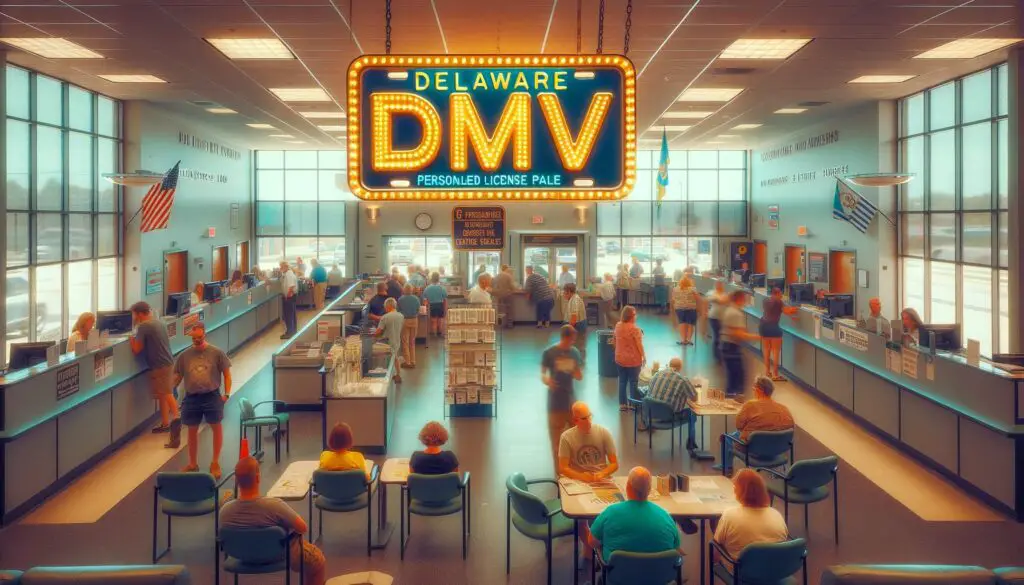Delaware’s personalized license plates offer a unique opportunity for drivers to express their individuality through their vehicles. In this comprehensive guide, we delve into the allure and history of personalized plates, along with the legal framework, design options, application process, cost breakdown, and more.
Understanding Personalized License Plates
Personalized license plates, commonly referred to as vanity plates, represent a distinctive form of self-expression for drivers seeking to imbue their vehicles with a touch of individuality. In Delaware, the allure of personalized plates transcends mere utility; it embodies a profound cultural significance deeply ingrained in the state’s motoring community.
The concept of personalized plates revolves around the customization of alphanumeric characters displayed on a vehicle’s license plate. Unlike standard plates that feature randomly assigned combinations, personalized plates empower drivers to craft a unique sequence that reflects their personality, interests, or affiliations. Whether it’s a clever play on words, a homage to a beloved hobby, or a nod to one’s profession, the possibilities for personalization are virtually endless.
The Legal Framework
Delaware’s Department of Motor Vehicles (DMV) has established comprehensive regulations to govern the issuance and usage of personalized license plates within the state. These regulations are designed to maintain order, ensure compliance with state laws, and uphold the integrity of the personalized plate program.
1. Eligibility Requirements
Before applying for a personalized plate in Delaware, drivers must meet certain eligibility criteria set forth by the DMV. These requirements typically include:
- Possession of a valid Delaware driver’s license or vehicle registration.
- Compliance with any outstanding fines or fees owed to the DMV.
- Adherence to specific guidelines regarding the content of personalized plate requests.
2. Content Restrictions
The DMV imposes strict guidelines regarding the content that can be displayed on personalized plates. Drivers must adhere to the following restrictions:
- Prohibition of offensive or inappropriate language.
- Avoidance of any combination of characters that may be deemed offensive, derogatory, or misleading.
- Compliance with size and formatting requirements for alphanumeric characters.
3. Prohibited Characters
Certain characters or combinations thereof are prohibited from appearing on personalized plates in Delaware. These restrictions may include:
- Obscene or vulgar language.
- Racial slurs or hate speech.
- References to illegal activities or substances.
4. Review Process
Upon submission of a personalized plate application, the DMV conducts a thorough review to ensure compliance with all regulations and guidelines. This review process may involve:
- Verification of eligibility requirements.
- Scrutiny of proposed plate content for adherence to content restrictions.
- Confirmation of availability of requested plate combination.
5. Approval and Issuance
Once the personalized plate application is approved, the DMV proceeds with the issuance of the plate. The driver is typically notified of approval and provided with instructions for obtaining the plate, which may include:
- Payment of associated fees and charges.
- Collection of the personalized plate from a designated DMV location.
- Installation of the plate on the driver’s vehicle in accordance with DMV guidelines.
6. Renewal and Compliance
Drivers are responsible for renewing their personalized plates within the specified timeframe to maintain compliance with Delaware’s regulations. Renewal procedures typically involve:
- Payment of renewal fees.
- Verification of continued compliance with content restrictions.
- Replacement of plates if damaged or lost.
7. Enforcement and Penalties
The DMV enforces compliance with personalized plate regulations through periodic audits and inspections. Drivers found to be in violation of these regulations may face penalties, including:
- Fines or citations for non-compliance.
- Suspension or revocation of personalized plate privileges.
- Requirement to surrender plates deemed non-compliant.
Design Options and Creativity
When embarking on the journey to design a personalized license plate in Delaware, drivers are tasked with navigating through the available characters and limitations set by the Department of Motor Vehicles (DMV). Despite these constraints, there exists a wealth of opportunities for creativity, allowing individuals to craft plates that are not only distinctive but also imbued with personal significance.
1. Understand Character Limitations
The first step in designing a personalized plate is to familiarize oneself with the character limitations imposed by the DMV. In Delaware, plates typically consist of a combination of letters, numbers, and special characters, with a maximum number of characters allowed. By understanding these limitations, drivers can tailor their plate designs accordingly and ensure compliance with DMV regulations.
2. Choose Meaningful Themes or Concepts
While the character limitations may seem restrictive, they also serve as a catalyst for creativity. Drivers are encouraged to brainstorm themes or concepts that hold personal significance, such as hobbies, interests, or meaningful phrases. Whether it’s a reference to a favorite sports team, a beloved pet’s name, or a motivational mantra, incorporating meaningful elements into the plate design can add depth and authenticity to the customization process.
3. Utilize Wordplay and Creativity
One of the most effective ways to infuse creativity into a personalized plate design is through the use of wordplay and clever combinations. By playing with phonetics, abbreviations, or double entendres, drivers can create plates that are not only visually appealing but also engaging and memorable. However, it’s essential to strike a balance between creativity and clarity, ensuring that the intended message is easily discernible to fellow motorists.
4. Consider Visual Elements
In addition to alphanumeric characters, drivers may have the option to incorporate visual elements or graphics into their personalized plate designs. Whether it’s a small icon or symbol that complements the chosen theme or a stylized font that enhances readability, visual elements can elevate the aesthetic appeal of the plate and make it stand out on the road.
5. Seek Inspiration and Feedback
Designing a personalized plate is a highly personal endeavor, but seeking inspiration and feedback from friends, family, or online communities can provide valuable insights and perspectives. Exploring examples of creative plate designs or engaging in collaborative brainstorming sessions can spark new ideas and help refine the overall design concept.
6. Review and Refine
Before finalizing the design, it’s essential to review the proposed plate carefully and consider any potential implications or interpretations. Double-checking for spelling errors, unintended connotations, or ambiguous messaging can help ensure that the final design accurately reflects the intended message and aligns with personal values and preferences.
Application Process
Obtaining a personalized license plate in Delaware is a straightforward process, whether you choose to apply online or in-person. Below, we provide a step-by-step guide outlining the necessary documents and information needed to complete the application successfully.
1. Gather Required Documents and Information
Before initiating the application process, ensure you have the following documents and information on hand:
- Valid Delaware driver’s license or vehicle registration.
- Vehicle identification number (VIN) for the vehicle the personalized plate will be assigned to.
- Payment method for associated fees and charges.
2. Choose Your Plate Design
Decide on the design for your personalized plate, including the combination of letters, numbers, and any special characters you wish to include. Take into consideration any character limitations imposed by the Delaware DMV.
3. Access the Delaware DMV Website
To apply online, visit the Delaware DMV website and navigate to the personalized plate application section. If applying in-person, locate the nearest DMV office and ensure you have the necessary time set aside for the application process.
4. Complete the Application Form
Whether online or in-person, you’ll be required to complete an application form for your personalized plate. Provide accurate and up-to-date information, including your personal details, vehicle information, and desired plate design.
5. Submit Required Documentation
Along with the application form, you may need to submit additional documentation, such as proof of vehicle ownership or identification. Ensure all required documents are included to expedite the processing of your application.
6. Pay the Required Fees
Personalized plate applications typically incur associated fees and charges, including initial application fees and any applicable processing fees. Be prepared to make payment using the accepted payment methods specified by the Delaware DMV.
7. Await Approval
Once your application is submitted, it will undergo review by the Delaware DMV. The processing time may vary depending on the volume of applications received. You can track the status of your application online or contact the DMV for updates if applying in-person.
8. Receive Your Plate
Upon approval, you will receive notification from the Delaware DMV regarding the status of your personalized plate application. If approved, you will be provided with instructions for obtaining your plate, whether through mail delivery or in-person pickup at a designated DMV location.
9. Install Your Plate
Once you’ve received your personalized plate, ensure it is properly installed on your vehicle following the guidelines provided by the Delaware DMV. Improper installation may result in fines or penalties, so it’s crucial to adhere to the specified installation instructions.
Cost Breakdown
When obtaining a personalized license plate in Delaware, it’s important to consider the various costs involved to ensure proper budgeting. Below is a breakdown of the expenses associated with personalized plates:
1. Initial Application Fees
Upon submitting an application for a personalized plate, drivers are required to pay an initial application fee. This fee covers the administrative costs associated with processing the application and verifying the requested plate design. The exact amount of the application fee may vary, so it’s advisable to check with the Delaware Department of Motor Vehicles (DMV) for current pricing information.
2. Renewal Costs
After the initial application and issuance of the personalized plate, drivers must renew their plates periodically to maintain their validity. Renewal costs typically include a renewal fee, which covers the administrative expenses of processing the renewal application and ensuring continued compliance with DMV regulations. Similar to the initial application fee, the renewal fee may vary, so drivers should consult the DMV for accurate pricing details.
3. Potential Hidden Fees
In addition to the upfront application and renewal costs, drivers should be aware of potential hidden fees associated with personalized plates. These fees may include:
- Special processing fees for expedited applications or rush orders.
- Replacement fees for lost or damaged plates.
- Transfer fees if transferring a personalized plate to another vehicle or owner.
- Late fees for renewals submitted after the expiration date.
It’s essential to review the DMV’s fee schedule and terms of service carefully to understand any potential hidden fees and avoid unexpected expenses.
Waiting Period and Approval Process
When applying for personalized plates in Delaware, drivers should familiarize themselves with the waiting period and approval process to manage expectations effectively. Below is an overview of the typical waiting period and steps to take in case of application denial:
1. Average Processing Times
The processing time for personalized plate applications in Delaware may vary depending on various factors, including the volume of applications received and the efficiency of the Department of Motor Vehicles (DMV) processing system. On average, drivers can expect the processing of their application to take several weeks to months. However, it’s essential to note that processing times may be longer during peak periods or if additional documentation or verification is required.
2. Application Review
Upon submission of the personalized plate application, the DMV conducts a thorough review to ensure compliance with all regulations and guidelines. This review process includes verification of eligibility requirements, scrutiny of the proposed plate content, and confirmation of the availability of the requested plate combination. The DMV may also conduct background checks or additional screenings as needed.
3. Notification of Approval or Denial
Once the application review is complete, drivers will receive notification from the DMV regarding the status of their application. If approved, drivers will be provided with instructions for obtaining their personalized plate. However, if the application is denied, drivers will receive a notification outlining the reasons for denial and any steps they can take to address the issue.
4. Steps to Take in Case of Denial
If a personalized plate application is denied, drivers have the option to appeal the decision or reapply with a modified plate design that meets the DMV’s regulations. It’s essential to carefully review the reasons for denial provided by the DMV and take appropriate action to address any deficiencies or issues identified. Drivers may need to provide additional documentation or make changes to the proposed plate design to ensure compliance with DMV guidelines.
5. Additional Assistance
For drivers facing challenges or uncertainties during the application process, the Delaware DMV offers additional assistance and support. Drivers can contact the DMV directly or visit their website for guidance on navigating the personalized plate application process, addressing application denials, or obtaining further clarification on specific requirements.
Installation and Maintenance
Proper installation and maintenance of personalized plates are essential to ensure they remain legible, visually appealing, and compliant with Delaware’s regulations. Below are guidelines for both installation and ongoing maintenance:
Installation:
- Secure Mounting:
- Ensure that the personalized plate is securely mounted to the vehicle using the designated mounting holes.
- Use appropriate fasteners, such as screws or bolts, to prevent the plate from becoming loose or detached while driving.
- Correct Placement:
- Position the personalized plate in accordance with Delaware’s regulations, typically in the designated license plate area at the front or rear of the vehicle.
- Ensure that the plate is mounted in a horizontal position and is clearly visible to law enforcement and other motorists.
- Avoid Obstructions:
- Avoid obstructing the personalized plate with accessories such as license plate frames, covers, or decals that obscure the characters or registration information.
- Maintain a clear line of sight to the plate to facilitate accurate identification and enforcement by authorities.
- Use of Proper Tools:
- Utilize appropriate tools, such as a screwdriver or wrench, to securely fasten the plate to the vehicle.
- Avoid over-tightening the fasteners, as this may damage the plate or mounting surface.
Maintenance:
- Regular Cleaning:
- Clean the personalized plate regularly using mild soap and water to remove dirt, debris, and road grime.
- Use a soft cloth or sponge to gently scrub the surface of the plate, avoiding abrasive materials that may scratch or damage the finish.
- Inspect for Damage:
- Periodically inspect the personalized plate for any signs of damage, such as cracks, fading, or peeling.
- Address any damage promptly to prevent further deterioration and maintain the plate’s integrity and visibility.
- Address Rust or Corrosion:
- If the personalized plate is made of metal and shows signs of rust or corrosion, treat the affected areas with a rust-inhibiting solution or primer.
- Consider applying a protective coating or sealant to prevent future rust formation and prolong the plate’s lifespan.
- Replace as Needed:
- If the personalized plate becomes damaged beyond repair or no longer meets Delaware’s requirements for legibility and compliance, consider replacing it with a new plate.
- Contact the Delaware Department of Motor Vehicles (DMV) to obtain a replacement plate and follow the necessary procedures for installation and registration.
Conclusion:
By following these guidelines for installation and maintenance, drivers can ensure that their personalized plates remain in compliance with Delaware’s regulations and maintain their visual appeal over time. Proper installation and regular upkeep contribute to the longevity and effectiveness of personalized plates in expressing individuality while adhering to legal requirements.
Personalized Plates as Gifts
Gifting a personalized plate in Delaware involves specific considerations and procedures that drivers should be aware of.
Special Interest and Cause-Related Plates
Delaware offers special interest and cause-related plates, each with its own application process and requirements.
Celebrity and Famous Delaware Plates
Exploring famous personalized plates in Delaware and the stories behind these unique choices offers insight and inspiration to drivers.
Legal Considerations and Compliance
Understanding the legal implications of personalized plates is essential to ensure compliance with Delaware’s laws and avoid plate revocation.
Changing or Surrendering Your Plate
Drivers should know how to change or surrender their personalized plates when necessary and the associated procedures for doing so.
Frequently Stolen Plates and Security Measures
Protecting personalized plates from theft is crucial, as they can be targeted by thieves for various reasons, including identity theft, vehicle cloning, or fraudulent activities. Here are common security measures and frequently stolen plates awareness:
1. Awareness of Commonly Targeted Plates:
- Plates with easily identifiable names or phrases.
- Plates with high-value characters or numbers.
- Plates associated with luxury or high-end vehicles.
- Plates featuring rare or unique combinations.
- Plates with sentimental or personalized messages.
2. Implementing Security Measures:
- Anti-Theft Screws: Install anti-theft screws or bolts to secure the plate to the vehicle. These specialized fasteners require unique tools for removal, deterring casual theft attempts.
- Security Cameras: Park vehicles in well-lit areas equipped with security cameras. Surveillance footage can help identify thieves and aid in the recovery of stolen plates.
- Garage Parking: Whenever possible, park vehicles in secure garages or parking structures to reduce the risk of plate theft.
- Plate Locking Devices: Consider using plate locking devices, which encase the entire plate assembly and prevent unauthorized removal.
- Regular Inspections: Periodically inspect the vehicle’s license plate to ensure it is securely attached and has not been tampered with or replaced.
- Report Suspicious Activity: Report any suspicious activity, such as individuals loitering around vehicles or attempting to remove license plates, to law enforcement authorities immediately.
3. Personalized Plate Protection:
- Non-Permanent Attachment: Avoid attaching adhesive frames or holders to personalized plates, as they can make it easier for thieves to remove the plate.
- Document Plate Details: Keep a record of your personalized plate details, including the plate number, design, and any unique features. This information can aid in the recovery process if the plate is stolen.
- Notify Authorities: In the event of plate theft, report the incident to local law enforcement and the Delaware Department of Motor Vehicles (DMV) promptly. Provide detailed information about the stolen plate to aid in recovery efforts.
The Future of Personalized Plates in Delaware
As we look ahead, several trends and potential changes are shaping the landscape of personalized license plates in Delaware, with technology playing a pivotal role in driving innovation and enhancing customization options. Here’s a glimpse into what the future may hold:
1. Digital Plate Solutions:
- Electronic Displays: Advancements in digital display technology may pave the way for electronic license plates capable of displaying dynamic messages, graphics, or even advertisements. These digital plates offer increased flexibility and personalization options for drivers while providing enhanced visibility and readability.
- Smart Plate Integration: Integration with smart vehicle systems and mobile applications could enable personalized plates to interact with other devices or networks. For example, drivers may be able to update their plate design or message remotely using a smartphone app, or receive real-time notifications about plate status and renewal reminders.
2. Enhanced Security Features:
- Anti-Theft Technologies: Continued development of anti-theft technologies, such as biometric authentication or GPS tracking, may help deter plate theft and facilitate recovery efforts in the event of theft or unauthorized removal.
- Tamper-Proof Design: Future personalized plates may incorporate tamper-proof materials or features, making them more resistant to forgery, alteration, or duplication. These measures enhance plate security and ensure the integrity of registration information.
3. Customization and Personalization:
- Expanded Character Options: With advances in manufacturing techniques and plate design capabilities, drivers may have access to a broader range of character options, including special symbols, emojis, or customizable fonts.
- Augmented Reality Integration: Integration with augmented reality (AR) technology could enable drivers to visualize and customize their plate design in real-time, using AR-enabled mobile applications or vehicle interfaces. This interactive experience enhances the customization process and allows for instant feedback on design choices.
4. Sustainability Initiatives:
- Eco-Friendly Materials: In response to growing environmental concerns, future personalized plates may utilize eco-friendly materials or production methods, reducing carbon footprint and promoting sustainability.
- Renewable Energy Integration: Integration of renewable energy sources, such as solar panels or kinetic energy harvesting, could power electronic license plates, reducing reliance on traditional energy sources and promoting energy efficiency.
5. Regulatory Changes:
- Legislative Updates: Continued review and adaptation of existing regulations governing personalized plates may be necessary to address emerging technologies and changing societal norms. Legislators may consider updates to accommodate digital plates, new security measures, or evolving design preferences.
- Public Engagement: Increased public engagement and feedback mechanisms may influence future policy decisions regarding personalized plates, ensuring alignment with driver preferences, community standards, and regulatory objectives.
Personalized Plate Ideas and Inspiration
Drawing inspiration from creative examples and offering tips on brainstorming personalized plate ideas encourages readers to embark on the customization journey.
Frequently Asked Questions
Here are answers to common queries regarding personalized plates in Delaware:
1. Can I reserve a personalized plate if I’m not ready to use it?
Yes, Delaware allows drivers to reserve a personalized plate for up to 90 days before they are ready to use it. This reservation period provides drivers with the opportunity to secure their desired plate combination without immediately placing it on a vehicle. However, drivers should be aware that reservations are subject to availability and may expire if not utilized within the specified timeframe.
2. Are there any words or combinations banned in Delaware?
Yes, Delaware prohibits the use of certain words or combinations that may be deemed offensive, derogatory, or misleading on personalized plates. Additionally, the DMV reserves the right to reject any plate design that violates state regulations or community standards. It’s essential to review the DMV’s guidelines for personalized plates to ensure compliance and avoid potential rejection or denial of the application.
3. How often do I need to renew my personalized plate?
Personalized plates in Delaware must be renewed annually, typically on the driver’s birthday or vehicle registration renewal date. Renewal notices are sent out by the DMV in advance, providing drivers with ample time to renew their plates before expiration. Failure to renew personalized plates on time may result in penalties or the loss of registration privileges, so it’s important to adhere to renewal deadlines.
4. What happens if my personalized plate is damaged or stolen?
If a personalized plate is damaged or stolen, drivers should report the incident to the Delaware DMV as soon as possible. Depending on the extent of the damage or the circumstances of the theft, drivers may need to obtain a replacement plate. The DMV can provide guidance on the necessary steps to take to replace a damaged or stolen personalized plate and any associated fees or documentation required.
5. Can personalized plates be transferred to another vehicle or owner?
Yes, personalized plates in Delaware can be transferred to another vehicle or owner under certain circumstances. To transfer a personalized plate, drivers must submit a transfer application to the DMV and pay any applicable fees. The new vehicle or owner must meet the eligibility requirements for personalized plates, and the transfer must be approved by the DMV before the plate can be transferred.
6. How can I check the availability of a personalized plate idea?
Drivers can check the availability of a personalized plate idea by using the online plate availability search tool provided by the Delaware DMV. This tool allows drivers to input their desired plate combination and check its availability in real-time. If the desired combination is available, drivers can proceed with the application process. If not, they may need to choose an alternative combination or explore other options.
Conclusion
In conclusion, personalized license plates in Delaware provide a platform for drivers to express their individuality while adhering to legal guidelines. We encourage readers to explore the process with creativity and compliance in mind.
Call to Action
Share your personalized plate stories or ideas in the comments and visit the Delaware DMV website to start the application process.
Read Related Articles :
- Personalized license plate in California
- Personalized license plate in Florida
- Personalized license plate in Pennsylvania
- Personalized license plate in Tennessee
- Personalized license plate in texas
- Personalized license plate in Alabama
- Personalized license plate in Alaska
- Personalized license plate in Arizona





